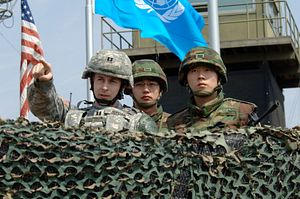The United States and South Korea began their annual two-week long joint war drill Ulchi Freedom Guardian (UFG) on Monday. The computer-aided exercise will involve 50,000 South Korea troops and 30,000 U.S. troops. The United States is additionally including 3,000 troops from bases outside of South Korea in the exercise. According to South Korea’s Yonhap News, “this year will be the first time for the allies to implement their customized deterrence plan against Pyongyang’s nuclear threats and weapons of mass destruction.” In general, the exercise is geared at maintaining preparedness for a North Korean assault against the South.
This year’s UFG exercise will focus on implementing the bilateral strategy that was drafted between the two sides during the 2013 defense ministerial. According to Yonhap, that strategy “delineates how they should work together to deter both wartime and peacetime aggression from Pyongyang, from saber-rattling to the actual use of force.” The exercise will take place over 12 days.
North Korea generally reacts poorly to exercises between the United States and South Korea. Earlier this year, it threatened to abandon scheduled family reunions as the U.S. and South Korea began their annual Foal Eagle exercise. A spokesman for the General Staff of North Korea’s Korean People’s Army issued a statement via North Korea’s KCNA on Sunday condemning the exercise. The statement alleges that the drill is “aimed to mount a surprise preemptive strike at the DPRK,” and noted that “the Korean-style most powerful and advanced merciless preemptive strike will start any time chosen by [North Korea].” The statement added that the U.S. and South Korea “will have to pay a dear price” for conducting the exercise.
The nature of U.S.-South Korea operational command during wartime may change in coming years as the two sides discuss the transfer of wartime operational control (OPCON) from Washington’s hands into Seoul’s. Under the current bilateral road map, the two sides will consult on OPCON transfer monthly until October this of year. The outcome of this year’s UFG could potentially be used to assess the ROK’s readiness for full OPCON in an inter-Korean conflict. OPCON transfer, however, could be pushed back as far as 2020 depending on when South Korea’s Korea Air and Missile Defense (KAMD) and Kill Chain preemptive strike systems are operational.
Also on Monday, a South Korean military source confirmed to Yonhap that North Korea is using a new specification of tactical rockets that pose a threat to major South Korean military facilities. According to the anonymous source, “The five short-range projectiles that North Korea fired off last week were found to be novel tactical missiles, according to our analysis jointly with the United States of the North’s photo of the rockets.”
Despite the North’s protests about the UFG exercise, South Korea unveiled an action plan for infrastructure development in North Korea, including plans to repair and renovate the highway between Kaesong, a special economic zone (SEZ) within North Korea, and the capital, Pyongyang. The South Korean unification ministry made the announcement on Monday, as UFG began. Kaesong is one of the few instances of successful cooperation between the two Koreas, who remain technically at war since 1953. The unification ministry also noted that South Korea could lift the “May 24” sanctions which banned all inter-Korean trade outside of Kaesong. Those sanctions were put in place after North Korea sank the ROKS Cheonan in 2010.

































